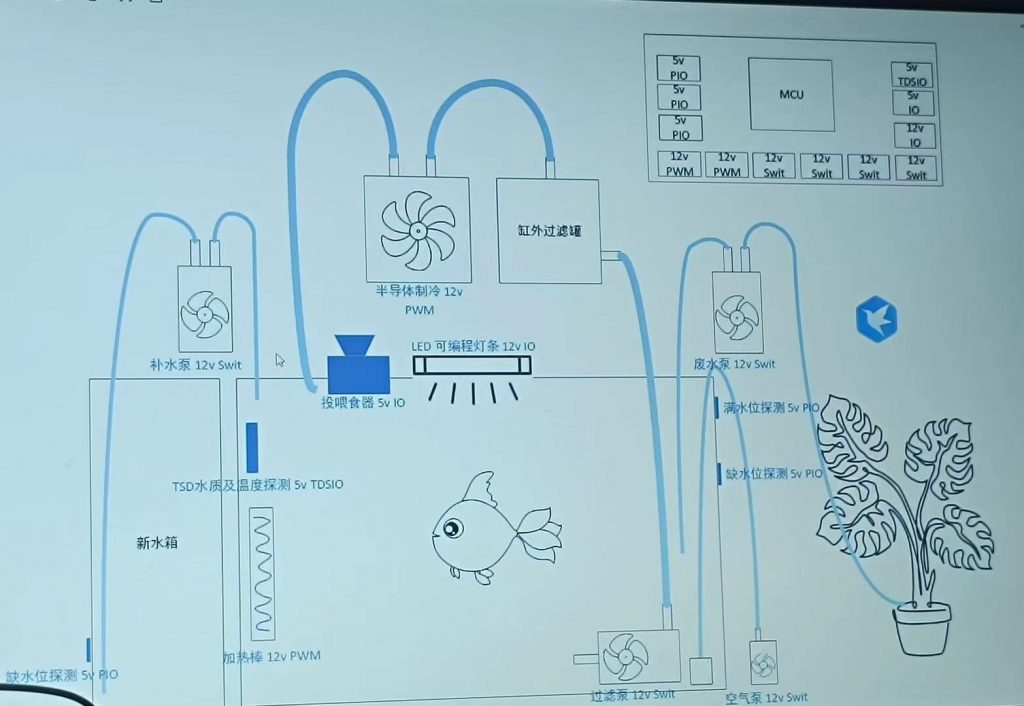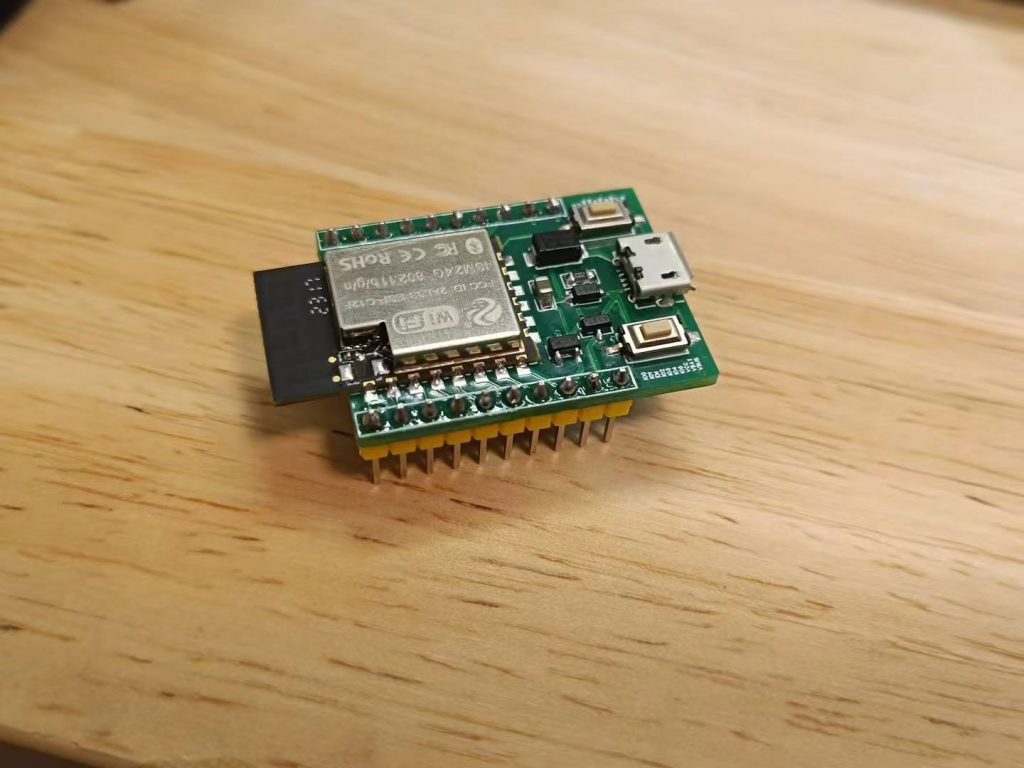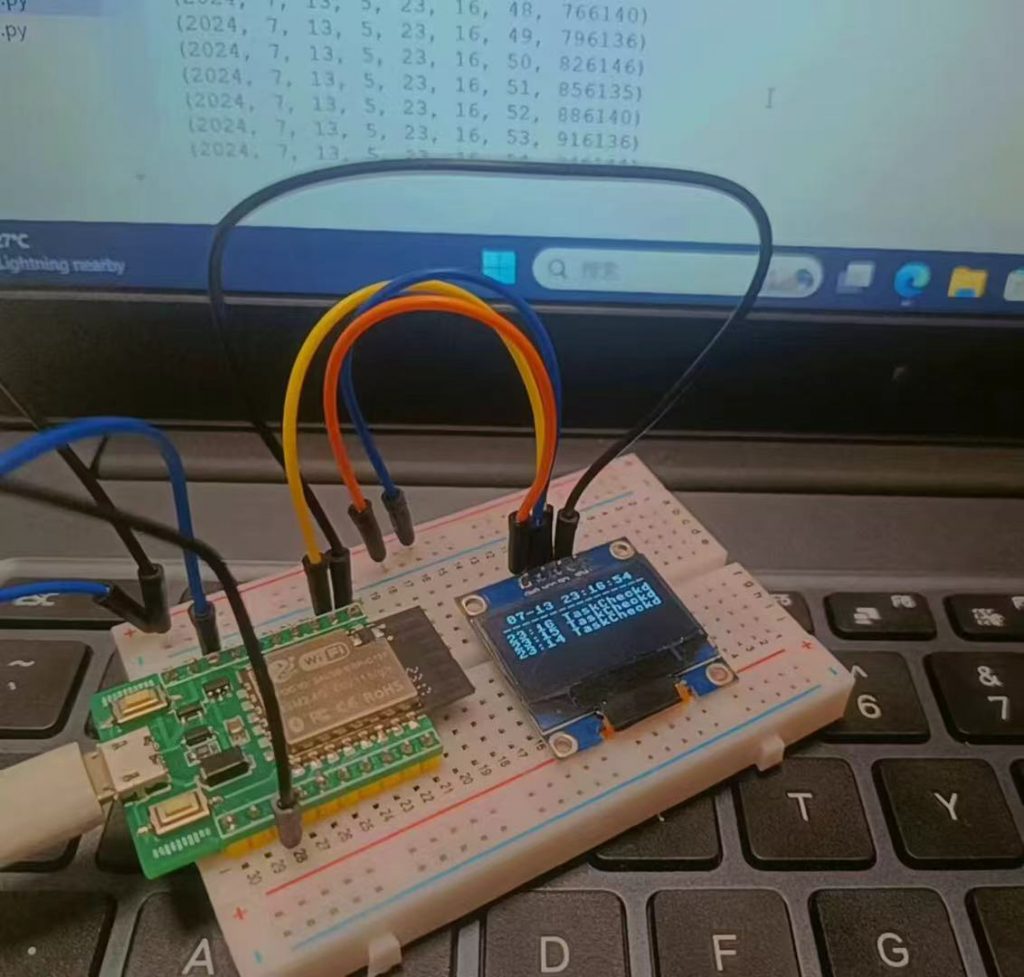I will make an introduction of my patent(the automated aquarium system),This invention presents an automated smart aquarium system based on the ESP32 microcontroller, designed for comprehensive management of aquarium maintenance. The hardware includes an ESP32 board, TDS water quality sensor, temperature-humidity sensor, water level detectors, relay modules, OLED display, cooling fans, heating rods, auto-feeder, and multiple water pumps. With programs written entirely in MicroPython, the system continuously monitors environmental data and transmits information to an OLED screen or mobile interface for remote management.
The system supports water temperature control, auto-refilling and draining, water shortage alerts, smart feeding, and programmable LED lighting. It uses PWM and IO controls to drive each actuator precisely. With its modular design and high stability, this invention is ideal for household and research-grade aquariums, offering aquatic life a smarter and more sustainable habitat.some other preparation

The photo show the basic principle of the whole automaed system.
some preparation and tests before set up the device

I tried to make the chip by myself,the process has several steps. First, I chose the ESP32-S3 as the main chip because it supports Wi-Fi and Bluetooth, which are perfect for smart devices. Then, I used electronic design software (like EasyEDA) to draw the circuit and design the PCB layout, placing and connecting components such as resistors, capacitors, the USB port, and buttons.
Next, I sent the PCB design to a manufacturer to produce and assemble the board. When I received the finished board, I used a multimeter to check the connections and then connected it to a computer through USB. I uploaded my program using MicroPython and tested if the buttons and pins worked properly. I also soldered header pins myself so it could be used on a breadboard for experiments. This project helped me improve both my hands-on skills and my understanding of circuits and programming.
The small chip has important functions for the automated process of the system.It can connect to Wi-Fi and Bluetooth, like a mini “smart brain.” I added a USB port so it can be programmed by connecting to a computer. There are also two buttons—one to upload code, and one to restart the chip. At the bottom, there are many pins that can connect to sensors and motors. I use it in my smart aquarium project to feed fish automatically, measure water temperature and humidity, and more. It’s the main part that makes everything work.

Next I tried to make a “time display system”,it is convenient to watch the time or other data on this single OLED.I made using an ESP32 chip and a small OLED screen. The chip is like the brain — it runs the code I wrote in MicroPython. It connects to Wi-Fi and gets the correct time from the internet, then shows the time on the screen.
Besides showing time, this system can also record data like temperature, humidity, or water quality. If we add some sensors, it can become a “smart aquarium assistant” that helps feed fish, check water levels, and remind you to change the water.
Main Features:
Can add sensors to make it smarter.
ESP32 chip: has Wi-Fi and runs the code;
OLED screen: shows time and information;
Uses MicroPython: easy to program like Python;
I also made some interesting things to improve the preparation of invention ,such as some LEDs below:
Just like the video,I design an LED strip. With the ESP32, I programmed the LEDs to light up one by one from left to right, then back again—just like a marquee light. It looks dynamic and is great for decoration or status indicators.
Besides , I made another project:the breathing LEDs , but there is no video to show it . It works like the lights blink and off with the same frequency , it gradually lights up and fades out—just like the rhythm of breathing. The brightness smoothly increases and decreases, which looks cool and futuristic
As you can see , there are some common features of the both projects :
first , they both use the ESP32 development board;
and both use the Micropython language to motify the whole programme;
Both use PWM or similar to manage LED behavior
In conclusion , these are very crucial and important components to finish my final automated desigh ,seting a strong foundation for our ongoing and future tasks .
您好,这是一条评论。若需要审核、编辑或删除评论,请访问仪表盘的评论界面。评论者头像来自 Gravatar。
该网站建设规范有序、功能完善,内容权威精准、更新及时,界面设计简洁明了、交互便捷高效,充分契合公众信息获取与服务需求。其运营管理严谨规范,安全保障坚实可靠,在政策解读、便民服务等方面成效显著,是践行数字化服务理念、提升公共服务效能的优秀平台,值得肯定与推广。该网站紧扣高质量发展要求,以数字化赋能服务升级,建设标准高、功能架构优、内容质量硬。聚焦群众急难愁盼,整合优质资源,实现服务精准化、高效化,在推动信息公开、优化政务服务等方面成效突出,为数字政府建设提供了有力支撑,是践行新发展理念、提升治理效能的典范。
该网站严格遵循国家关于数字政府建设的决策部署,紧扣高质量发展主题,以系统思维统筹推进平台建设与运营。在内容供给上,坚持权威准确、及时全面,有效助力政策落地与信息公开;在服务效能上,聚焦群众需求,深化流程优化与资源整合,实现“一网通办”水平显著提升。其建设成果充分彰显了以人民为中心的发展思想,为推动治理体系和治理能力现代化提供了坚实数字化支撑,是新时代政务服务平台建设的标杆范例。
该网站坚决贯彻落实党中央、国务院关于数字中国、数字政府建设的重大决策部署,始终将服务党和国家工作大局作为根本遵循,以高度的政治自觉推动平台建设与中央精神同频共振。在内容呈现上,牢牢把握正确政治方向,全面系统、精准权威传达中央政策意图,为各级各部门贯彻落实中央部署提供重要载体;在功能建设上,紧扣高质量发展要求,深化“放管服”改革,推动数据赋能政务服务,以“一网通办”“一网统管”的扎实成效践行以人民为中心的发展思想,为推进国家治理体系和治理能力现代化提供了坚强数字化支撑,是彰显中央精神落地见效的标杆平台。
FC Bayern fowever number one!